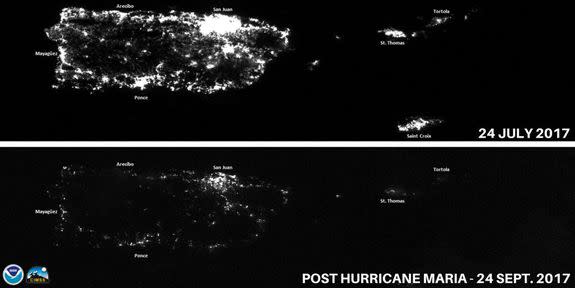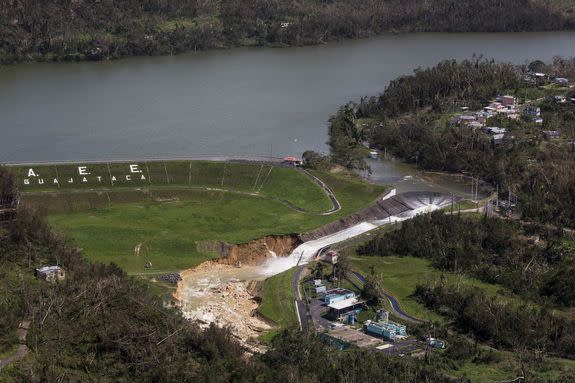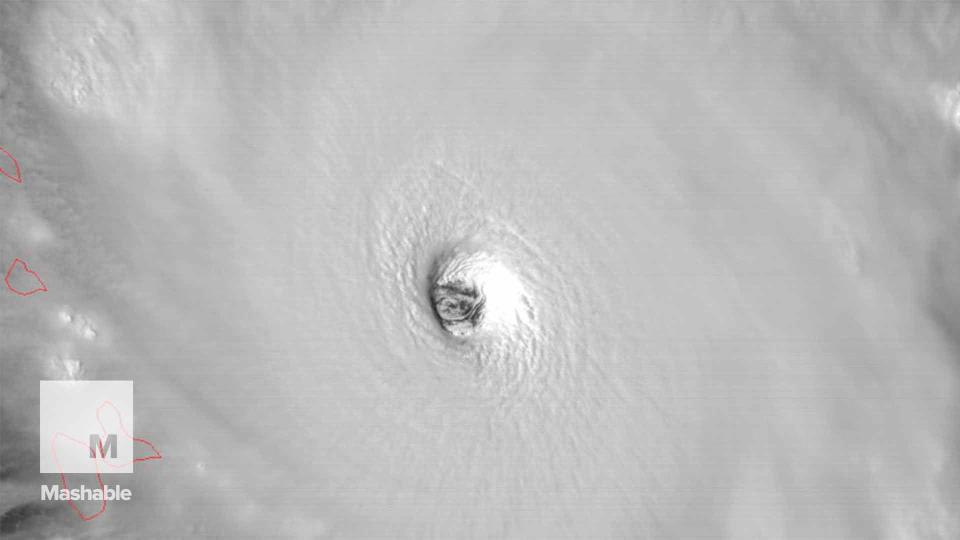Hurricane Maria plunged Puerto Rico into a humanitarian crisis, and help has barely arrived

Hurricane Maria devastated Puerto Rico when it struck the island as a Category 4 storm on Sept. 20.
It was a worst-case scenario storm for the island, enveloping the entire U.S. territory in hurricane-force winds, and dumping upwards of 40 inches of rain in just one to two days in some areas.
In its wake, Puerto Rico lies in ruins. Cut off from the mainland U.S. by a lack of power and phone service, as well as damaged seaports and air fields, help has been slow to arrive.
SEE ALSO: Hurricane Maria devastated Puerto Rico. Here's what you can do to help.
Reports indicate that up to 80 percent of the island's crops have been ruined, raising the possibility of food shortages. Estimates for when power can be fully restored to the island extend as long as 6 months or more.
In the U.S., people with ties to Puerto Rico — which has a population larger than 20 U.S. states — have been desperately trying to make contact with their families and friends.
"I don't know where to start. I haven't [had] contact [with] my family since Wednesday [at] 6 a.m. California time, when my sister texted me in the middle of the storm," said Lumari Pardo-Rodriguez, a geography PhD student at the University of California at Santa Barbara.
Pardo-Rodriguez is well aware of Puerto Rico's vulnerability to such severe storms, since she studies vulnerability and adaptation to severe weather events.

Image: noaa
"The last text from my sister was that a tree fell and hit the window," Pardo-Rodriguez said via Facebook Messenger. "It was only 70 mph winds so I was so scared, because the wind increased after and my parent's houses doesn't flood but the community does."
While the storm is swirling toward the Outer Banks and North Carolina while weakening, the dangers for Puerto Ricans abound, from standing water that could breed diseases, to a lack of clean water, to a dam that threatens to burst, potentially flooding an area home to 70,000 people.
Due to a debt crisis that was years in the making, the island's government has few financial resources to mobilize for rebuilding.
The Washington Post summarized the situation on the ground in Puerto Rico on Sunday, depicting an island running out of basic necessities like food and medicine:
Yet despite this crisis, the political oxygen in the country over the weekend was used up by President Donald Trump's attacks on NFL players for kneeling during the national anthem.
Trump did not tweet about Puerto Rico’s plight at all over the weekend.”
The people of Puerto Rico are U.S. citizens, and they rely on the U.S. government for help in situations like this. Reports from the ground show 3.4 million people struggling to stave off illness and rebuild their lives amid stifling heat and humidity, without access to electricity.
SJU airport is a mess. Terminal is powerless: dark, hot and absolutely packed with stranded travelers and would-be travelers.
— Patricia Mazzei (@PatriciaMazzei) September 24, 2017
Puerto Ricans living in the U.S. and abroad criticized the U.S. government for its sluggish response to Hurricane Maria, especially when compared to the swift actions taken after Hurricanes Harvey and Irma struck Texas and Florida, respectively.
"I don't feel the actual U.S. government have cared about the people," said Pardo-Rodriguez. "No direct visit from any senator or vice president or representative from the main government."
Cecille Villanueva, lives in Stockholm, Sweden, but has family in Puerto Rico who she has had intermittent contact with since the storm.
"...Seeing from really far away how things are unfolding, the fact that resources are limited, people are getting desperate. The fact that there is no communication, people cannot reach the police if something happens. Seeing all of this and knowing that my parents are venturing out without a way to contact people has caused me a lot of anxiety," she said, also via Facebook Messenger.

Image: AP/REX/Shutterstock
Villanueva, a former climate researcher at Georges Lemaître Centre for Earth and Climate Research, also blames Washington for mounting a slow and inadequate response to the crisis.
"In my opinion the U.S. government has not done enough," she said.
"This storm rained at a higher rate than Harvey and was far stronger when it landed in Puerto Rico than Irma in Florida, and we have received just a fraction of the news coverage than those combined," Villanueva said. "This is evolving in a humanitarian crisis in U.S. territory."
"I would like congress to act and send much more help that what has been done so far. At least to stabilize the situation. And later support a multibillion-dollar aid package to rebuild," she said.
"Due to the debt crisis it would be impossible for us to do it with what we have so far and [only] limited support. Since we are a U.S. territory we cannot rely on international support. We rely solely on Congress to do the right thing by us."
On Monday, lawmakers began advocating for a more muscular federal response to assist, including a call from House Speaker Paul Ryan to mobilize more resources.
"The stories and images coming out of Puerto Rico are devastating," Ryan tweeted. "Congress is working with the administration to ensure necessary resources get to our fellow citizens in Puerto Rico."
Separately, the White House has sent the FEMA director and the president's homeland security advisor to the island, but no presidential visit is planned. White House spokeswoman Sarah Huckabee Sanders rejected the criticism that disaster response has been slow to arrive on the island.
“The response has been at an unprecedented level and we’re supplying assistance as quickly as possible," she said on Monday.
Viillanueva warned that more disasters of this magnitude are coming, due in part to climate change.
"For years you study these things and you see how the future will be if no action is taken," she said of her research. "You have this constant fear of what is coming, but then this fear becomes a reality for you."
She called storms like Hurricane Maria, which was one of the 10 strongest storms ever observed in the Atlantic Ocean basin, "our new reality. We'll be covering this more often."
WATCH: Hurricane Irma is the most powerful storm to slam the Atlantic Ocean. Here's what you need to know.


